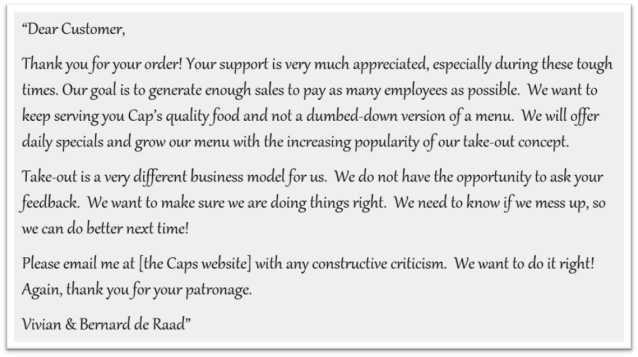Leadership in “Tough Times”
You can find examples of leadership anywhere if you look. I found one in (almost) my backyard!
We live on a barrier island within walking distance of a lovely waterfront restaurant. Over the five years we have lived here, we have watched the complete devastation of the restaurant after Hurricane Matthew, the commitment to come back bigger and better, how they used the lessons they learned with Matthew to cope with Hurricane Irma, and now, COVID-19.
As an onlooker and customer, I have been impressed with their resilience, their communication to their customers and their resolve to come back strong every time. They have emerged as one of the top waterfront restaurants in north Florida. Each time they come back they add little more pizzazz….a wine selection that rivals anything I’ve seen, seating where 90% (my personal estimate) of the diners can easily see the sun set over the Intracoastal Waterway, and a new welcome dock for diners arriving by boat.
They closed on March 17 because of COVID-19 and let their Facebook followers know in a heartfelt message about the difficulty of the decision. Three days later they opened for take-out. Someone on Facebook asked if they’d deliver to boats – the next day, their website announced boat delivery.
Since March 20 they’ve upped their game yet again, offering family-style meals and daily specials. They prepared us a lovely dinner last night. However I’m not intending to write about food, but rather about leadership.
When we opened our take-out bag, there was a hand-written letter folded inside the bag. It read:
While their history and this letter showcase myriad excellent leadership principles, I’d like to focus on two – authenticity and vulnerability. In my experience, these are so powerful yet often leaders are hesitant to invoke that power.
Being authentic
In my experience, leaders often stumble when delivering bad news. It’s difficult and uncomfortable and we’re taught as children, “If you can’t say anything good, don’t say anything.”
The problem with avoiding addressing bad news is that others can’t help but see the bad situation in front of them. Without leaders addressing it, others are left to wonder if the leader even sees it. That damages trust. If a leader can’t (or won’t) see it, she cannot be helpful at a time when help is needed.
The de Raads’ letter was authentic. They shared their challenges, goals and their commitment to their employees. To me that says they saw what was coming with the pandemic, set their priorities, and established a goal. And they shared this with their customers so that their customers could recognize how valuable it was to simply purchase a take-out meal.
Being authentic doesn’t mean saying the sky is falling. It is more about letting others know you see it and you are doing something. That builds trust.
Being vulnerable
Showing vulnerability is difficult for some. Those in leadership positions want to be competent, and vulnerability may appear to conflict with competence. It doesn’t.
Allowing oneself to show vulnerability means starting down a path of learning and growth. In a past article I told the story of a leader who thought being vulnerable meant allowing himself to cry in front of his team. Instead it made the team terribly uncomfortable and they lost confidence in his ability to be strong.
As a customer, I love seeing that my input to the restaurant is valued, but it takes vulnerability to ask for it. The de Raads put themselves out there sharing how they were in a learning curve on a whole new business model. I suspect it’s energizing for the employees to know that they’re a valued part of developing this new business model.
Vulnerability is not weakness it is strength. It says that I know where my strengths are, what my weaknesses may be and that I am wise enough to know that there are blind spots I need help seeing. Vulnerability means that I acknowledge I may not know, but I want to learn.
Being vulnerable enables others to “know” and teach; to add value.
Don’t underestimate others
The lack of authenticity and vulnerability in leaders may mean they want to “know” and be right or it may mean they don’t have confidence in others.
Underestimating others, whether customers or employees, doesn’t make a leader look strong. A leader who thinks he can sugar coat a message is doing a real disservice to others and to herself. She is underestimating those listening and making herself look ignorant.
In times of crisis, we need leadership strength. We need leaders who can and will deliver the blunt facts, while plotting the course for learning how to be better.
I love leadership lessons from everyday life. Now, if you’ll excuse me, it’s dinnertime at Caps on the Water! Thank you Vivian and Bernard for letting me share your letter and your story!


